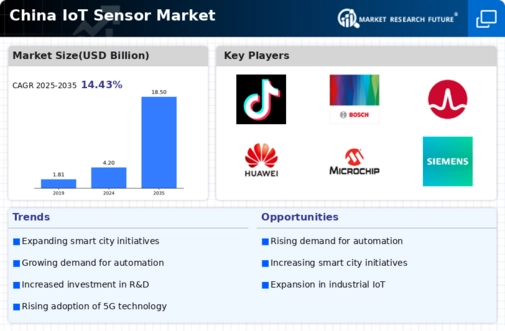Government Initiatives and Support
The Chinese government is actively promoting the development of the iot sensor market through various initiatives and policies. Investments in smart infrastructure and digital transformation are being prioritized, with the aim of enhancing the country's technological capabilities. For instance, the government has allocated approximately $10 billion to support research and development in IoT technologies. This financial backing is expected to stimulate innovation and attract private sector investments, thereby expanding the market. Furthermore, regulatory frameworks are being established to ensure the safe and efficient deployment of IoT solutions, which could lead to a more robust iot sensor market in the coming years.
Rising Consumer Electronics Adoption
The surge in consumer electronics adoption in China is another critical driver for the iot sensor market. With the increasing popularity of smart home devices, such as smart thermostats and security systems, the demand for IoT sensors is expected to rise. As of 2025, it is estimated that the smart home market will reach a valuation of $50 billion, with IoT sensors playing a vital role in this growth. This trend indicates a shift in consumer behavior towards more connected and automated living environments. As a result, the iot sensor market is likely to benefit from this growing consumer interest, leading to further innovation and product development.
Growing Focus on Industrial Automation
The increasing emphasis on industrial automation in China is driving demand for the iot sensor market. As industries seek to enhance productivity and reduce operational costs, the integration of IoT sensors into manufacturing processes is becoming more prevalent. It is projected that by 2026, the industrial automation sector will account for over 30% of the total market share in the iot sensor market. This shift towards automation not only improves efficiency but also enables real-time monitoring and predictive maintenance, which are essential for minimizing downtime. Consequently, the iot sensor market is poised for significant expansion as more companies adopt these technologies.
Emphasis on Environmental Sustainability
The growing awareness of environmental sustainability is influencing the iot sensor market in China. As industries and consumers alike become more conscious of their ecological footprint, there is an increasing demand for IoT solutions that facilitate energy efficiency and resource management. For instance, smart sensors that monitor energy consumption and optimize usage are gaining traction. It is projected that the market for environmental monitoring sensors will grow by 25% annually through 2027. This trend reflects a broader commitment to sustainable practices, which is likely to drive the adoption of IoT technologies, thereby enhancing the overall iot sensor market.
Advancements in Wireless Communication Technologies
The rapid evolution of wireless communication technologies is a pivotal driver for the iot sensor market in China. Enhanced connectivity options, such as 5G, are facilitating real-time data transmission, which is crucial for the effective functioning of IoT devices. This advancement allows for the deployment of a larger number of sensors across various sectors, including manufacturing and healthcare. As of 2025, it is estimated that the penetration of 5G technology in urban areas could reach 70%, significantly boosting the capabilities of IoT applications. Consequently, the iot sensor market is likely to experience substantial growth, as businesses increasingly adopt these technologies to improve operational efficiency and data accuracy.
























Leave a Comment